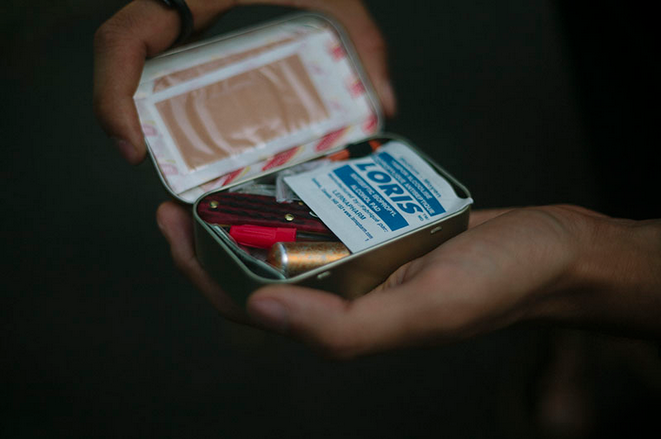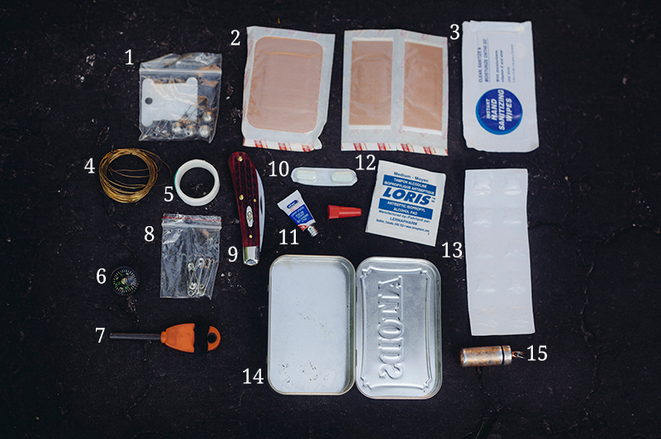Just remember, the kit is small so be careful. The items to pack need to be small, of course, but also practical. Here are some samples of what you can put in your kit!
1. Fishing kit with line, hook, and sinkers. Like this one. This is definitely for a prolonged survival scenario, and realistically, I am unlikely to ever use it. That being said, its compact size makes it an easy choice to bring along; it takes up no space that I would rather use a different way.
2. 3 x Large Elastoplast band-aids. From this box. I love Elastoplast, as I find their band-aid quality to be above average, when it comes to adhesives used and flexible fabric. Not at all a fan of plastic band-aids, as for me, they fall off too quickly to truly be useful.
3. Hand wipes. Like these. Genuinely “handy” products (yes, pun intended). Especially great at disinfecting those little cuts.
4. Brass snare wire. Like the one found here. Much like the fishing kit, its day to day applications are limited, but the wire could certainly prove invaluable in a true survival situation.
5. Medical tape. Like this one. You will count your lucky stars for having this on you if you ever have any larger wounds in an emergency situatoin, especially if you don’t have a trauma pad around. Fashioning a trauma pad out of fabric with medical tape would be a decent enough replacement if you’ve got nothing else you can use.
6. Button compass. The one here. Okay, so I will say upfront that this is not the most accurate compass (you want an accurate compass, you get a Suunto, but those don’t fit into an Altoids tin!), but for general navigation, it’s damn useful to have on you, and fits nicely into the inside of the roll of tape (what else are you gonna get in there? – always make the most of the space you have!).
7. Fire steel. The Light My Fire Mini. I pretty much always carry one of these on my keychain, but the goal of this survival kit is for it to be self-contained (i.e. in the event of an emergency, if you have nothing, you should be able to grab this and be okay with only its contents; so forget what you have EDC’d in your pockets). In Canada, the cold is the biggest issue, and I tend to always carry the means to start fire just in case I get stranded someplace (an unlikely scenario, but it can happen). Even if cold isn’t an issue where you are, you should probably keep a firesteel on you just in case. If you can get a fire lit, you can cook, frighten animals away, disinfect water… there are a lot of advantages to being able to get a fire lit.
8. Safety pins for clothing & medical emergencies. Here (though you probably already have many around the house). You can see the pattern of choosing small objects that offer situational flexibility whilst not taking up much room here!
9. Case Wharncliff folding knife. The Case Cutlery Pocket Worn Sway Back Gent. A good knife is worth its weight in gold and I don’t go anywhere without one. You can see this one reviewed here if you’re interested.
10. Imodium. Which you can pick up here. Food poisoning is more likely to take place when I am out and about than the systematic collapse of society, so I plan accordingly. If I feel I might get the runs, just one of these will stop that from taking place. Being a foodie, I don’t ever leave home without a few caps of Imodium – just in case. Imodium has situational applications beyond mere food poisoning, however. It can force your bowel movements to regulate when faced with adverse conditions and extreme changes in diet (like eating gathered and wild food with little to no carbs when you’re used to a regular carb-heavy diet). Just don’t use it in excess or super regularly (which you wouldn’t if you’re only planning on pulling it out for emergencies), and you’re good to go!
11. Superglue. Like these. An absolutely fantastic choice for sealing small cuts. Learn how to tell whether to use super glue, stitches, or band aids here.
12. Disinfectant pad. One of these. It’s probably not surprising, but with the sheer amount of knives I own (and play with), I do tend to incur cuts pretty regularly. Definitely a must have for me.
13. Water purification tabs. Like the ones from this bottle. Once again this is an item that I am extremely unlikely to ever need (even if I’m in a real survival situation, there are a lot of streams, and tonnes of precipitation and thus rain water for me to gather up here in Canada), but as the old adage goes – I would rather have it and not need it than need it and not have it.
14. The tin is an item in itself. Mine was the Ginger box. Yes, it’s small and it’s unlikely you will be able to use it as a primary container in a real SHTF situation but as a way to keep tinder dry, make charcloth, and as a reflective surface to get help, it functions pretty damn well. Like much in life, value is determined by what the possessor can do with it – not the object itself.
15. This lil’ water tight capsule which contains another Imodium tab & a teensy tiny compass. Water capsule like this one, and a magnetic ball compass that I can’t seem to find the equivalent of online. Once again, I plan for life’s likely scenarios whilst packing 2 or 3 small items as backups – “just in case”. You can also keep some tinder in here (but chances are, whether you’re indoors or outdoors, you’ll be able to find something dry and flammable unless you’re in the rain forest), or a tylenol or something like that. Your call there!
Basically, you want to pack your little kit based on your given situation or environment. There is no absolute rule. Some people live in the city and others in the country. One might need a first aid kit and mirror while another would do better by having a fishing kit.
For more information go to More Than Just Surviving. The author will give you tips, tricks and a personal insight of having your own small survival kits and also explain why he is not so fond of prepacked kits.
In conclusion, if you use something out of your kit, replace it. That way it will be fully stocked if an emergency should arise.



Joe Dunn